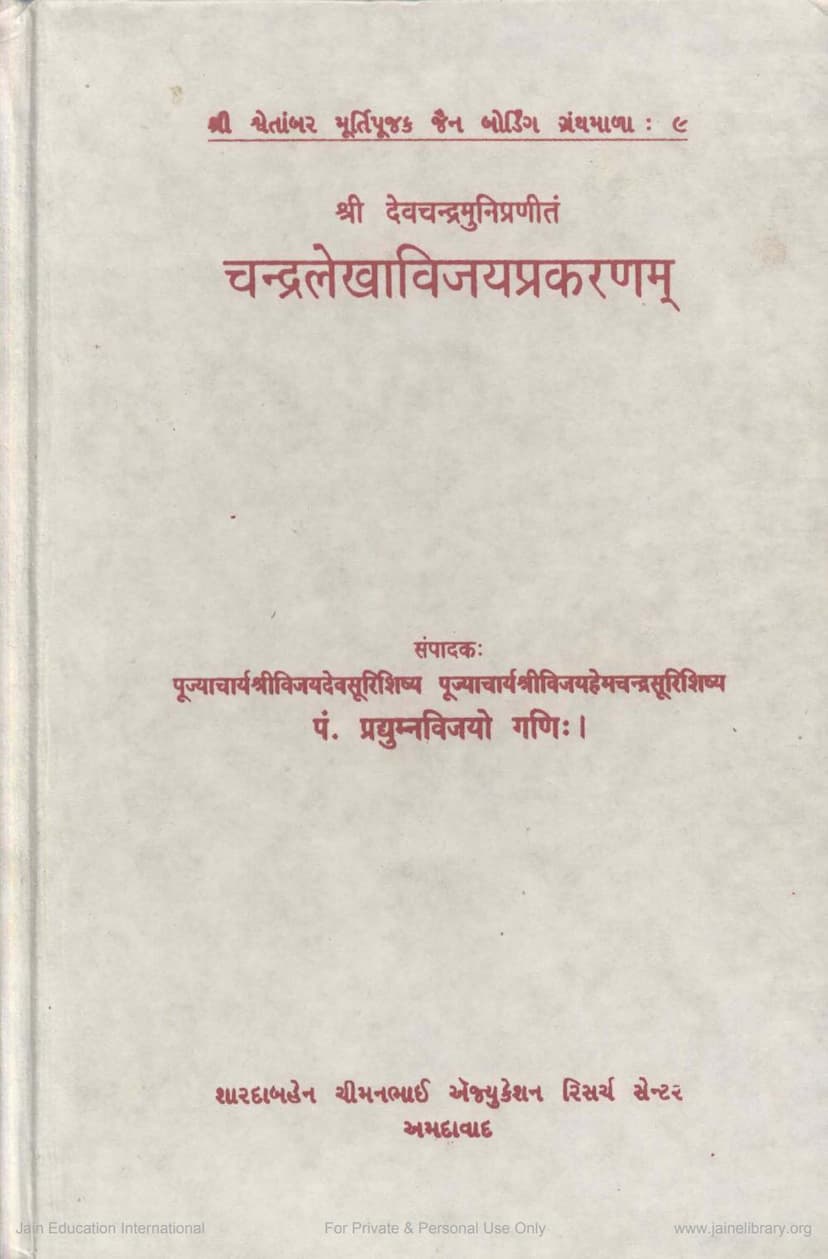Chandralekhavijayprakaranam
Added to library: September 1, 2025

Summary
Here is a comprehensive summary of the Jain text "Chandralekha-Vijayprakaranam," based on the provided information:
Title: Chandralekha-Vijayprakaranam Author: Devchandramuni Editor: Muni Pradyumnavijayagani Publisher: Shardaben Chimanbhai Educational Research Centre Year of Publication: 1995 (First Edition, August 1995) Language: Prakrit (play), with extensive scholarly introduction and analysis in Gujarati and Sanskrit. Genre: A five-act play (Prakaranam)
Overview:
The "Chandralekha-Vijayprakaranam" is a significant Jain dramatic work attributed to Devchandramuni, a disciple of the renowned Hemachandracharya. The play, written in Sanskrit, is a dramatic representation of events centered around the protagonist Vijay and his relationships, interspersed with philosophical and spiritual themes characteristic of Jain literature. The play's publication is a notable achievement, given that only a single, fragmented manuscript existed in the Jaisalmer Gyanbhandar. The rigorous editorial work undertaken by Muni Pradyumnavijayagani was crucial in bringing this work to light.
Key Aspects and Themes:
-
Literary and Historical Significance:
- The play is considered a valuable contribution to Sanskrit drama, particularly from the Solanki and Vaghela periods of Gujarat, a time renowned for its rich Sanskrit literary output, with Jain scholars playing a dominant role.
- The surviving manuscript is incomplete, with several pages missing, making the editorial task exceptionally challenging. This necessitated extensive textual research and reconstruction.
- The play showcases Devchandramuni's mastery of Sanskrit, evidenced by his sophisticated use of language, poetic embellishments, and adherence to dramatic conventions.
-
Author's Background (Devchandramuni):
- Devchandramuni was a prominent scholar and poet among the disciples of Hemachandracharya.
- He was known for his erudition in Sanskrit, Prakrit, and Apabhramsha languages.
- Besides "Chandralekha-Vijayprakaranam," another known work attributed to him is "Vilasa-vati-Natika" (also known as "Manmudra-bhanjana").
- His works suggest a deep understanding of various branches of knowledge, including mantra sastra (science of mantras), as indicated by the references to mystic syllables and their interpretations within the play.
-
The Play's Plot and Structure (Prakaranam):
- The play is categorized as a "Prakaranam," a type of Sanskrit drama characterized by its focus on worldly affairs and human conduct.
- Main Rasa (Dominant Emotion): The play primarily features Shringara Rasa (the erotic or romantic sentiment), culminating in a happy ending (Sukhaanta).
- Characters:
- Hero (Nayak): Vijay, who is a devout follower of Jain principles.
- Heroines (Nayikas): Chandralekha and Deviprabha, Vijay's two wives.
- Son: Ratnapunj.
- Plot Outline: The narrative involves the separation and eventual reunion of Vijay and his wives, Chandralekha and Deviprabha. The plot is filled with miraculous events, divine interventions, and the resolution of past karmic connections.
- Act 1 (Priya-laabha): Introduces Vijay, his divine destiny stemming from past life austerities (chanting the Pancha-Paramesthi mantra), and the predicament of Chandralekha, who is cursed by a rakshasi (demoness) and transformed into a swan. Vijay is guided by divine beings and prophecies to rescue Chandralekha.
- Act 2 (Chakravarthi-Janana): Focuses on Deviprabha, her pregnancy, abandonment by her parents due to societal stigma, and her eventual protection by divine forces. The birth of their son, Ratnapunj, who is destined to become a Chakravarti (universal monarch), is described.
- Act 3 (Vaitadya-Arohana): Depicts Vijay's life with Chandralekha in Mayapuri, their joyous interactions, and the challenges they face, including Chandralekha's jealousy and abduction, and Vijay's subsequent rescue mission. The act includes descriptions of nature and romantic dialogues.
- Act 4 (Siddha-Akshata-Labha): Describes Ratnapunj's ascension to kingship in Ujjain. Vijay, still deeply missing Chandralekha, receives divine guidance and support, including the acquisition of sacred rice (Siddhakshata) which aids in achieving great spiritual powers (Maha-siddhi).
- Act 5 (Maha-Siddhi-Labha): Concludes the play with the performance of a complex ritual (Maha-Charu-paak) involving divine beings, tantric practices, and the ultimate attainment of great powers by Vijay. The story emphasizes the importance of devotion, divine grace, and the fulfillment of destiny, leading to a harmonious reunion of the family and the establishment of their son's reign.
-
Mantra and Mysticism:
- A distinctive feature of the play is the extensive use of cryptic mantras and their detailed interpretations by the author. These mantras are presented as instrumental in overcoming obstacles and achieving desired outcomes.
- The play incorporates elements of tantra and mantra sastra, reflecting the author's knowledge and interest in these fields. The specific mantras, often cryptic and multi-layered in meaning, are a subject of scholarly interest.
-
Editorial and Publishing Efforts:
- The publication project was a collaborative effort, involving the Shardaben Chimanbhai Educational Research Centre and scholars like Muni Pradyumnavijayagani, who dedicated significant time and effort to editing and preparing the manuscript.
- The publication highlights the efforts to preserve and promote Jain literary heritage, making ancient texts accessible to a wider audience.
In essence, the "Chandralekha-Vijayprakaranam" is a sophisticated Jain drama that blends classical Sanskrit literary traditions with the philosophical and ethical tenets of Jainism. It tells a compelling story of love, destiny, divine intervention, and the pursuit of spiritual liberation, offering valuable insights into Jain religious thought and the rich cultural landscape of medieval Gujarat.